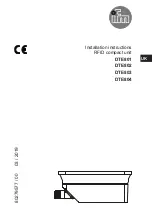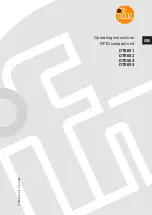
40
User's Guide Fireface 802
© RME
19. Analog Inputs
19.1 Line Rear
The Fireface has eight balanced Line inputs as 1/4" TRS jacks on the back of the unit. The elec-
tronic input stage is built in a servo balanced design which handles unbalanced (mono jacks)
and balanced (stereo jacks) correctly, automatically adjusting the level reference.
When using unbalanced cables with TRS jacks: be sure to connect the 'ring' contact of the
TRS jack to ground. Otherwise noise may occur, caused by the unconnected negative input
of the balanced input.
One of the main issues when working with an AD-converter is to maintain the full dynamic
range within the best operating level. Therefore the Fireface 802 internally uses hi-quality elec-
tronic switches, which allow for a perfect adaptation of all rear inputs individually to the three
most often used studio levels.
Additionally amplification from 0 to +12 dB is available, in steps of 0.5 dB. This fine adjustment
over a greater area allows to match even lower levels very precisely. This stage is a digital gain
circuit which basically reduces the signal to noise ratio by the amount of currently set gain. In
real-world applications the Fireface 802 has such a low noise level that it doesn’t matter. What-
ever you connect to the Fireface has more self-noise than its AD-stage. Therefore the digital
gain can be used in most cases without any loss of quality, and proves to be a very useful and
flexible tool.
The Fireface 802 uses the following level references:
Referenz
0 dBFS @
Headroom
Gain
Lo Gain
+19 dBu
15 dB
0 dB
+4 dBu
+13 dBu
9 dB
0 dB
-10 dBV
+2 dBV
12 dB
+4 dBu with 8.5 dB
The above levels are also found in all other RME devices. Therefore they are fully compatible to
each other.
19.2 Microphone / Line / Inst Front
The four sevo-balanced microphone inputs of the Fireface 802 use XLR/TRS combo jacks. A
two colour LED displays present signal (green, from –46 dBFS) and warns against overload (0
dBFS).
XLR
The gain range of the XLR inputs is 54 dB, adjustable from +6 dB to +60 dB. This equals a sen-
sitivity from +10 dBu down to -44 dBu, referenced to full scale of the AD-converter. The soft
switching, hi-current Phantom power (48 Volt), switchable per channel, provides a professional
handling of condensor mics. The usage of a hi-end integrated circuit (That 1510) guarantees
outstanding sound quality, lowest THD, and maximum Signal to Noise ratio in any gain setting.
Up to a level of +10 dBu, the front XLR input can also be used as Line input.
Summary of Contents for Fireface 802
Page 7: ...User s Guide Fireface 802 RME 7 User s Guide Fireface 802 General...
Page 12: ...12 User s Guide Fireface 802 RME...
Page 13: ...User s Guide Fireface 802 RME 13 User s Guide Fireface 802 Installation and Operation Windows...
Page 28: ...28 User s Guide Fireface 802 RME...
Page 29: ...User s Guide Fireface 802 RME 29 User s Guide Fireface 802 Installation and Operation Mac OS X...
Page 38: ...38 User s Guide Fireface 802 RME...
Page 39: ...User s Guide Fireface 802 RME 39 User s Guide Fireface 802 Inputs and Outputs...
Page 47: ...User s Guide Fireface 802 RME 47 User s Guide Fireface 802 Stand Alone Operation...
Page 50: ...50 User s Guide Fireface 802 RME...
Page 51: ...User s Guide Fireface 802 RME 51 User s Guide Fireface 802 TotalMix FX...
Page 53: ...User s Guide Fireface 802 RME 53...
Page 89: ...User s Guide Fireface 802 RME 89 User s Guide Fireface 802 Class Compliant Mode...
Page 94: ...94 User s Guide Fireface 802 RME...
Page 95: ...User s Guide Fireface 802 RME 95 User s Guide Fireface 802 Technical Reference...
Page 106: ...106 User s Guide Fireface 802 RME 36 Diagrams 36 1 Block Diagram Fireface 802...
Page 108: ...108 User s Guide Fireface 802 RME...
Page 109: ...User s Guide Fireface 802 RME 109 User s Guide Fireface 802 Miscellaneous...
















































